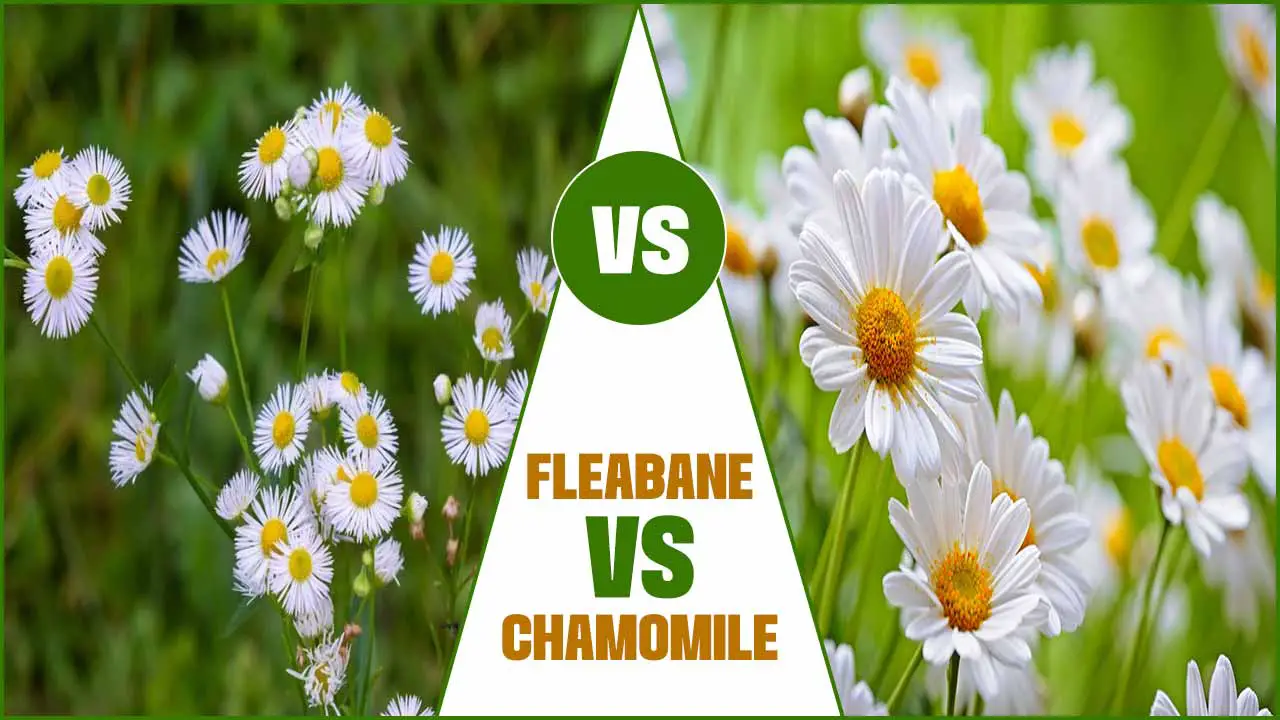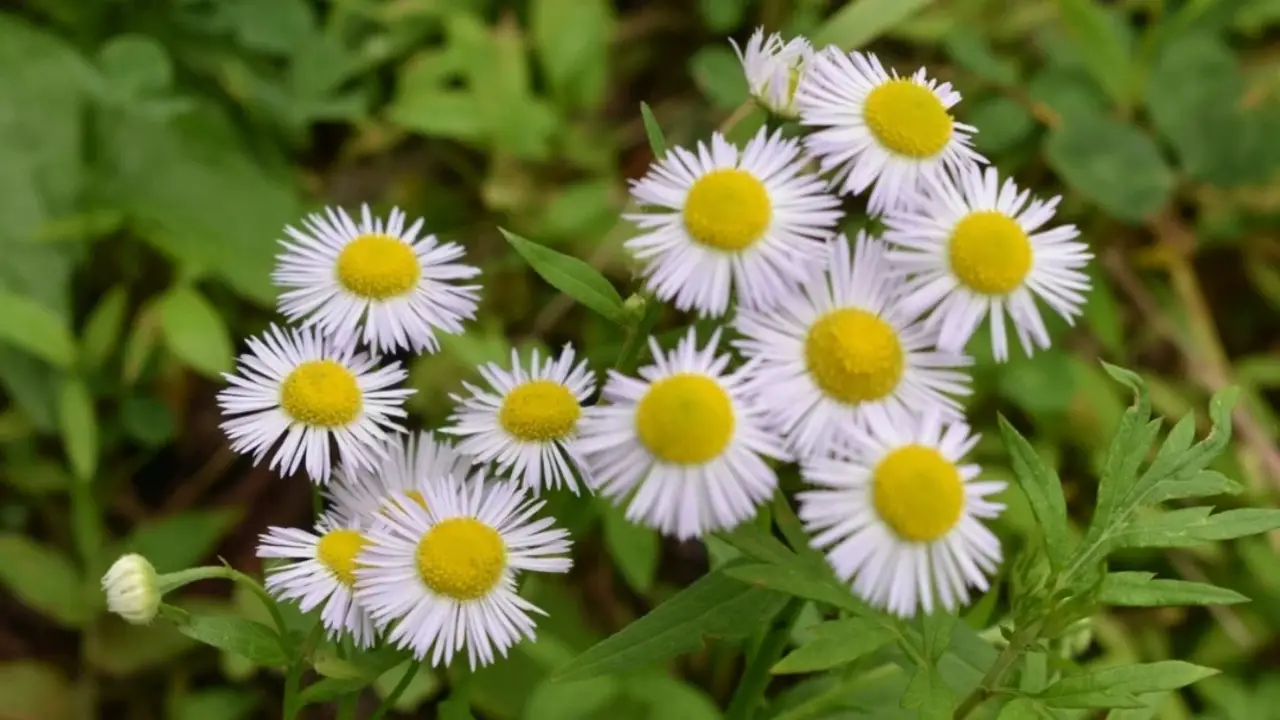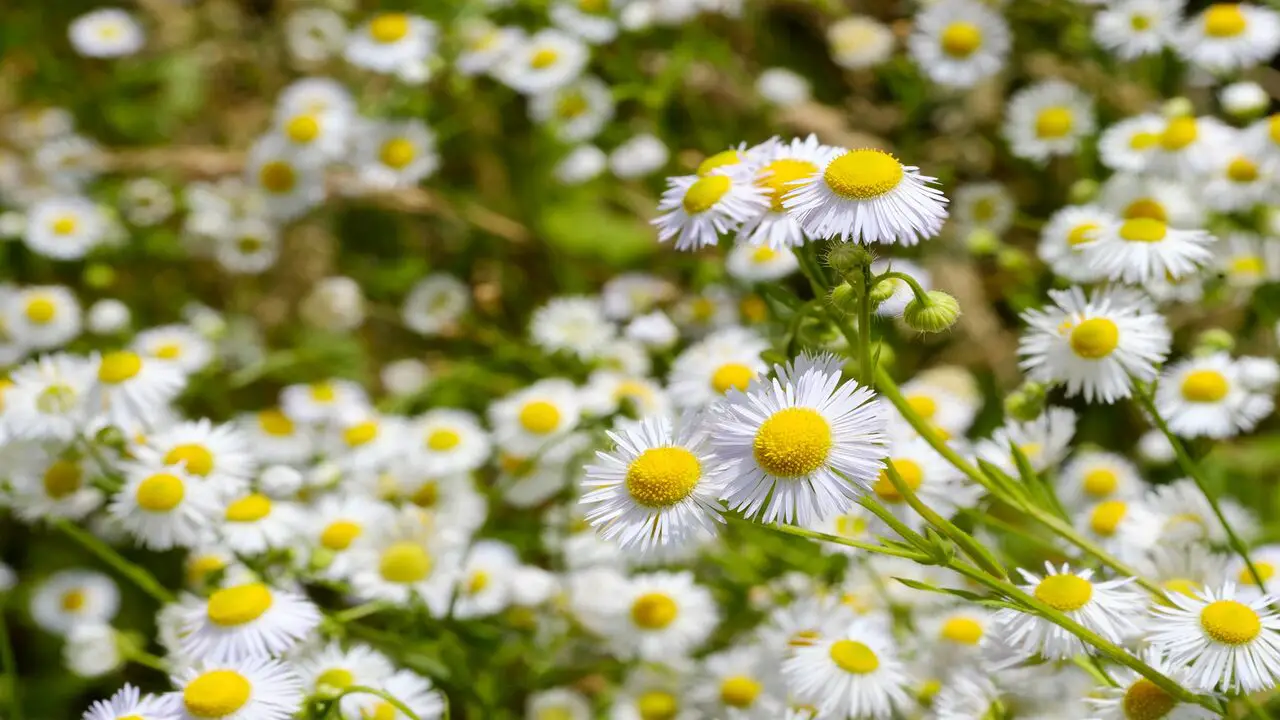Fleabane and chamomile are two common herbs that have been used for centuries in various traditional medicines and remedies. Both of these plants have a long history of medicinal use and are known for their unique properties and benefits.
However, despite their similarities, these two herbs have distinct differences that make them stand out from one another. While both are widely recognized for their medicinal benefits, they differ in their uses, growing conditions, and physical characteristics.
Here, we will compare fleabane vs chamomile , exploring their characteristics, uses, and potential health benefits. By the end, you will have a better understanding of these two powerful herbs and be able to determine which one may be more suitable for your specific needs.

Fleabane Vs Chamomile – In Detail Compare

Fleabane and chamomile plants can be distinguished based on their appearance, scent, growth habits, medicinal properties, and uses in gardening. However, fleabane plants have small, daisy-like flowers with yellow centres, while chamomile plants have larger, white, or yellow flower head with distinct cone-shaped centres.
Fleabane plants often have a pungent or unpleasant odour, whereas chamomile plant species have a sweet, apple-like scent. Its plants grow tall and upright, while chamomile plants are usually shorter and more compact. Below we compare in detail on Fleabane vs chamomile
What Is Fleabane?

Fleabane is a type of flowering plant that belongs to the Asteraceae family. Its name comes from its ability to repel fleas and other insects. The plant produces small, Oxeye daisy-like flowers ranging in colour from white flowers to pink or purple.
Fleabane has a long history of use in traditional medicine, particularly in treating skin conditions and as an insect repellent. Some natural remedies use it to treat digestive issues and menstrual cramps.
While fleabane may have some beneficial properties, a healthcare professional should provide proper guidance before ingesting or using it, as it may have side effects or interactions with certain medications.
What Is Chamomile?

Chamomile is a flowering plant that belongs to the daisy family. It has been used for centuries as a natural remedy for various ailments, and people know it for its calming and soothing properties. People commonly consume chamomile tea from the plant’s dried flowers to promote relaxation and improve sleep quality.
The plant has a mild, floral aroma and a pleasant taste, making it a popular choice for herbal infusions. Chamomile’s anti-inflammatory and antioxidant properties make it a common ingredient in skin care products and its use in teas. Chamomile offers a range of health benefits, and people can enjoy it in many different forms, making it a versatile herb overall.
Physical Characteristics Of Fleabane Plants
Fleabane plants are easily distinguishable by their physical characteristics. Slender stems typically grow up to three feet tall, and elongated, toothed leaves give them a slightly jagged appearance.
The flowers of the fleabane plant are small and daisy-like, with delicate white petals surrounding a yellow center. These flowers cluster in dense, rounded clusters at the top of the stems. Fleabane plants are graceful and airy, making them a lovely addition to any garden or landscape.
Physical Characteristics Of Chamomile Plants

Chamomile plants feature soft, feathery, fern-like leaves that are gentle to the touch. Scentless chamomile flowers have a daisy-like appearance with white petals and a vibrant yellow centre. These blooms emit a sweet and apple-like fragrance. Chamomile plants grow close to the ground and form dense mats or clumps. People often brew chamomile tea for relaxation because it has calming properties.
Differences In Leaves And Stems
You can easily distinguish fleabane and chamomile plants by their leaves and stems. Fleabane plants have long, slender leaves that are hairy and rough to the touch, while chamomile plants have feathery, fern-like leaves that are smooth.
Regarding stems, fleabane stems are tall and erect with multiple branches, while chamomile stems are shorter and more compact with fewer branches. Additionally, fleabane flowers are small and daisy-like, with white or pale purple petals surrounding a yellow center.
In contrast, chamomile flowers are larger and daisy-like, with white petals and a yellow centre. The distinct differences in leaves and stems make it crucial to identify these plants for their varied uses and properties correctly.
Differences In Flowers
Fleabane plants bear small, daisy-like flowers featuring yellow centres and white or pink petals. In contrast, chamomile plants produce larger, daisy-like flowers with yellow centres and drooping white petals. Fleabane flowers are generally smaller and more abundant compared to chamomile flowers.
Furthermore, the petals of fleabane flowers may exhibit a narrower and more pointed shape when compared to chamomile petals. The distinctive flower shape and size can aid in distinguishing between fleabane and German chamomile plants.
Differences In Aroma And Taste
Fleabane plants emit a strong, pungent aroma, while chamomile plants have a sweet, apple-like scent. People know fleabane leaves for their bitter taste, whereas chamomile leaves have a mild, slightly floral flavor. Fleabane flowers come in white or pink and are small, while differences between chamomile flowers have a yellow centre surrounded by white petals and are larger.
People value fleabane as a natural insect repellent, while they cherish chamomile for its calming properties and commonly use it in herbal teas. When differentiating between these plants, one should consider the scent and taste of their leaves and flowers.
Uses Of Fleabane And Chamomile Plants

Contrary to their similar appearance, fleabane and chamomile plants have distinct uses. People primarily consider fleabane, a wildflower with small daisy-like flowers, a weed in gardens and pastures.
People do not commonly use it for medicinal purposes. Chamomile, a herb with larger daisy-like flowers, has been used for centuries for its calming and soothing properties. You can brew it into tea or incorporate it into skincare products. These plants serve different purposes despite their resemblance.
Common Locations To Find Fleabane And Chamomile Plants
The same family includes Fleabane and daisy vs. chamomile plants, which can be found in different locations. Fleabane plants typically bloom in open fields, meadows, or along roadsides, showcasing clusters of small, daisy-like flowers with white, pink, or purple petals.
On the other hand, chamomile plants are commonly seen in gardens, lawns, or disturbed areas, displaying delicate white or yellow flowers resembling differences between daisies. Identifying these plants correctly is crucial, as some fleabane species can be toxic. The average chamomile plant has calming properties; people often use it in herbal teas and natural remedies.
Medicinal Uses And Benefits Of Fleabane

Fleabane is a plant that has been used for its medicinal properties for centuries. Some of the potential benefits and uses of Fleabane include. It is important to note that while Fleabane has a long history of traditional use, scientific research on its efficacy and safety is limited. As with any herbal remedy, it is recommended to consult with a healthcare professional before using Fleabane for medicinal purposes.
- Anti-Inflammatory Properties: Fleabane traditionally use to reduce inflammation and soothe irritated skin.
- Digestive Aid: It has use to calm digestive issues such as indigestion, bloating, and stomach cramps.
- Respiratory Support: Fleabane may help alleviate respiratory conditions such as coughs, bronchitis, and asthma.
- Pain Relief: It use topically to relieve pain from muscle aches and joint inflammation.
- Antimicrobial Properties: Fleabane contains compounds that may have antimicrobial effects, making it potentially useful for fighting infections.
Medicinal Uses And Benefits Of Chamomile
Chamomile is a versatile herb that use for centuries for its medicinal properties. Some of the benefits and uses of chamomile include. These are just a few examples of the many benefits and uses of chamomile. It always recommend to consult with a healthcare professional before using any herbal remedies for specific health concerns.
- Promotes Relaxation And Sleep: Chamomile tea is well-known for its calming effects and can help to reduce anxiety and promote better sleep.
- Soothes Digestive Issues: Chamomile can help to ease symptoms of digestive problems such as bloating, indigestion, and stomach cramps.
- Relieves Menstrual Pain: Chamomile has anti-inflammatory properties that can help to alleviate menstrual cramps and discomfort.
- Supports Skin Health: Chamomile can use topically to soothe irritated or inflamed skin conditions such as eczema or dermatitis.
- Boosts The Immune System: Chamomile contains antioxidants that can strengthen the immune system and protect against various illnesses.
When it comes to using Fleabane or Chamomile, there are a few tips to keep in mind to ensure their
Tips For Using Fleabane Or Chamomile Safely And Effectively

safe and effective use. Here are some key points to consider. By following these tips, you can safely and effectively incorporate Fleabane or Chamomile into your wellness routine.
- Always consult with a healthcare professional before using any herbal remedies, including Fleabane or Chamomile.
- Follow the recommended dosage instructions provided on the product packaging or by your healthcare provider.
- If you are pregnant or breastfeeding, it is especially important to seek guidance from a healthcare professional before using these herbs.
- Be aware of any potential interactions with medications you may be taking. Certain medications can interact with herbal remedies, so it’s important to disclose all medications you are currently taking to your healthcare provider.
- Store these herbs in a cool, dry place away from direct sunlight to maintain their potency.
- If you experience any adverse reactions or side effects while using Fleabane or Chamomile, discontinue use and consult with a healthcare professional.
Conclusion
Fleabane vs chamomile are two plants that are often compared due to their similar medicinal properties. Both plants have been handy for centuries as a natural remedy for various ailments, including digestive issues, skin irritations, and insomnia.
Understanding the differences between fleabane and chamomile native plants is crucial for making informed choices in gardening or herbal remedies. While both plants may have similar appearances, they differ in physical characteristics, aroma, taste, and uses.
You can ensure you are utilizing the right herb for your specific needs by correctly identifying these plants. Whether seeking relief from pests or a calming herbal remedy, fleabane and chamomile can be valuable additions to your repertoire. Take the time to explore their properties further and make an informed decision based on your individual needs.
Frequently Asked Questions
[rank_math_rich_snippet id=”s-d724262c-1e97-4dc7-9792-303ac1974959″]

I am passionate about home engineering. I specialize in designing, installing, and maintaining heating, ventilation, and air conditioning systems. My goal is to help people stay comfortable in their homes all year long.

